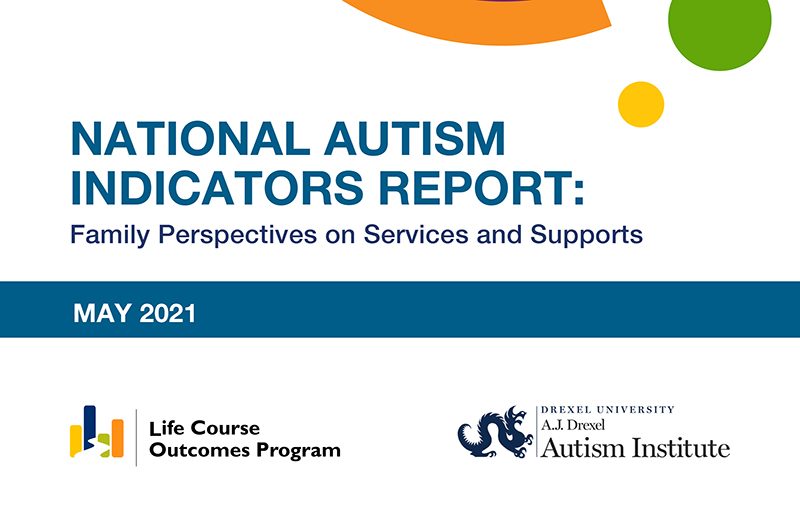In the latest National Autism Indicators Report, researchers from Drexel University’s A.J. Drexel Autism Institute examined surveys of family members of autistic adults who use Developmental Disability services, and found needs for additional supports like respite care and assistance to plan for crisis and emergencies, especially among families whose adult lived with them.
Data from the surveys showed over one quarter of families with autistic adults who use Developmental Disability services and live with family do not have enough services or supports for themselves, according to the report. And over half of these families indicated a need for respite care to enable them to take a break from caregiving.
Four in 10 families had not discussed preparation for handing crises or emergencies within the previous year at a care team meeting, whether the autistic adult lived with family or apart from family in a group home or other setting. Researchers noted this may have left families ill-equipped to handle illness and unforeseen changes in caregiving needs during the COVID-19 pandemic.
“During the pandemic, families of autistic adults faced complications related to loss of direct support providers, loss of structure provided by daytime activities and a need for extreme precautions due to increased risk of serious illness in this population,” said Lindsay Shea, DrPH, leader of the Life Course Outcomes Research Program and director of the Policy and Analytics Center at the Autism Institute. “The pandemic highlighted just how dangerous lack of emergency preparation can be for families of autistic adults. Who will care for your loved one if you become sick and require hospitalization?”
Lead author Anne Roux, a research scientist at the Autism Institute, and her team looked at data from several thousand families across states that participated in the Adult Family Survey and the Family/Guardian Survey conducted in 2018-2019 as part of the National Core Indicators – a collaborative effort to collect data to help improve the quality of states’ Developmental Disability services.
Gaps in Resources
This is the first National Autism Indicators Report to examine the needs of families whose loved ones use Developmental Disability services, as little data is available that specifically explores the needs of caregivers. Past reports have shown that households of youth on the autism spectrum were more likely to experience financial hardship. While this latest report on families found that only 37% of families with an adult living with them received payment for the care they provided, despite the fact that they may be less able to work due to need for supervision and additional caregiving demands.
Among families whose autistic adult did not live with them, 10% reported abuse or neglect within the past year. Many of these individuals live in congregate group settings in which families sometimes feel they have little choice about which staff provide care for the adult.
“This rate seems very concerning. Having competent, trained direct support staff can make a huge difference in the confidence of family members who are relying on hired personnel to provide skilled care and supervision,” said Roux. “The top concern of parents of autistic adults is what will happen to their son or daughter when they are no longer able to care for them. You’re talking about a group of people with disabilities who have high rates of additional physical and mental health conditions and high levels of support needs for managing distressed behavior. Families need to be involved in planning for the delivery of essential services and supports. No family member wants to turn over this level of care to strangers.”
Yet, few policies govern services and supports for families, and not enough planning or resources are devoted to addressing the dilemma of aging caregivers within a growing population of adults on the autism spectrum.
Barriers to Community Participation
Although many families reported their loved one participated in activities in the community, only one-third had any type of paid daytime activities. About 40% of adults who lived with family, and 60% of those who lived apart from family, were engaged in facility-based work in settings that did not include people without disabilities. Hispanic autistic adults were less likely to participate in community-based activities or to have paid work compared to those who were non-Hispanic white, Black or other/mixed race.
About one in every three families felt like their adult did not have enough support to be able to work or volunteer in the community. “Despite this, families reported high levels of satisfaction with the supports and services their adult received,” Roux said. “At the same time families reported barriers to community participation including stigma in the community or not having adequate staffing to support the adult to do activities in the community.”
The report is a snapshot of a segment of autistic adults who are receiving services. The researchers know there is likely a sizable population of adults with autism who don’t receive Developmental Disability services and really need them.
“Some states don’t provide Developmental Disability services for adults with autism unless they also have intellectual disability. These policies ignore the fact that many autistic adults are cognitively-able but still have tremendous challenges navigating the social, organizational and communication demands of adult life,” Roux explained.
“It’s critical that we put in place state policies that appropriately recognize and adequately meet the unique needs of the growing group of adults on the autism spectrum who need state Developmental Disability services, including the family members who are such vital care partners,” said Shea.
The National Autism Indicators Report series is written in a format that can be understood by non-scientists who need the information, particularly decision- and policy makers. Autism Institute researchers aim to fill a need and desire for usable information. The purpose of indicators is to describe where people are now and have a comparison for measuring changes in the future.

